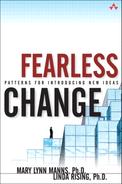Foreword
There is increasing pressure on our organizations to flourish in a rapidly changing world. We all need to play a part in creating new ideas that will enable our organizations to succeed; we must commit to sharing, adopting, and building upon solid foundations. This is especially relevant to knowledgeintensive companies, particularly those facing a digital economy in which technology has become more complex and deeply woven into the fabric of the business. The ability of these learning organizations to generate and utilize ideas is fundamental and crucial to success.
The nature of learning organizations has been debated for a number of years. Leaders recognize the need to develop and manage new ideas as intellectual capital and transform the knowledge that is disseminated around our companies into workable practices. Many views on how this intellectual capital might be managed exist, as there is little disagreement that addressing the issue is timely and critical. Introducing new ideas into organizations is a challenge that faces us all.
Business value and the productive exploitation of technology have always been important to Microsoft. As a Microsoft business value consultant working with a wide variety of commercial and noncommercial organizations, I understand that achieving highly beneficial uses of new technologies depends on individuals’ work styles and patterns of behavior. In many cases the best ideas about ways to take advantage of technology come from within the organization, often from unexpected quarters where workers are quietly utilizing technology in innovative ways for business benefit. The business value challenge becomes one of helping individuals at all levels in the organization to develop fresh ideas and then introduce these concepts more widely into the organization.
Incorporating new ideas into organizational practice continues to face leaders and workers alike. Some of us within Microsoft champion the importance of achieving business value from the productive exploitation of technology; we are passionate about this idea. At Microsoft, so many bright people are brimming with new ideas every day, and it is always a challenge to highlight your own. In this competitive environment it is even more challenging to finalize and implement new ways of operating when the organization evolves so quickly. Our shared passion stems from developing ideas and championing them, whatever one’s level at Microsoft. Finding new and sustainable ways of achieving business advantage through technology exemplifies this challenge.
Indeed, we use patterns that Mary Lynn and Linda describe to communicate our enthusiasm. We regularly hold Brown Bag sessions and take advantage of other opportunities as Evangelists. We use External Validation from respected organizations to bring credibility to our endeavors, and we hold significant events off site (Location, Location, Location) with the support of Local Sponsors so as to convince others in the organization (Personal Touch). Mary Lynn and Linda encourage us to keep a Sustained Momentum as well.
Your organization has its own distinct culture and methods of introducing new ideas. Whether it encourages or discourages new ideas, explore patterns outlined in this text. For example, finding a Corporate Angel or engaging in Corridor Politics may work for you. Does your organization recognize and value new ideas but need help exploiting them? Creating a Group Identity could provide focus and direction.
The most innovative and competitive organizations are those that make the most of their employees’ skills and knowledge. Yet imparting knowledge in a way that makes it recognizable and valuable to others has proven problematic for some time. The authors offer patterns in this book which outline a practical structure for capturing that hard-to-record knowledge; they share “how to do it” gems and capture the subtleties of a deep subject matter expert’s knowledge. The experience reports demonstrate that both the structure and language work.
This book does not serve as a prescriptive cookbook of sorts, but then change rarely ever occurs in predictable stages. Whether you are introducing change in an organization, creating new networks, finding innovative levels of empowerment that involve participation at all levels, or simply aiming to work smarter, you could try out a Brown Bag, set up an e-Forum, or share your passion as an Evangelist. Whether you decide to Involve Everyone or Just Do It, remind yourself that there are many ways to Test the Waters, and you should proceed Step by Step. Either by dipping straight into using the patterns or by studying them more methodically, let Mary Lynn and Linda guide you toward those strategies that will work for you.
